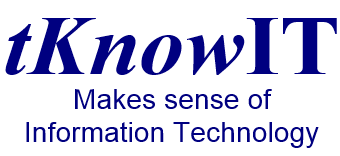Remember t’ Back I.T. up
Losing data such as designs, contracts and invoices in business can be costly; one survey suggested that only 6% of companies survive from a catastrophic data loss. At home, losing personal CVs, letters and digital photos can be heart-breaking too.
Virus attacks, computer crashes and hard disk failures can all lead to corrupt or lost files, programs or even the operating system. Accidently pressing delete on the wrong file can also be a problem.
In its simplest form making a backup involves copying and pasting your files from your computer onto an external source such as a CDROM, USB Memory stick or External Hard Disk. Files or folders should be copied and not moved. Copying means you have a duplicate of the original – moving it means you have just moved the risk elsewhere; External sources such as those mentioned are prone to loss or damage also.
For home users, memory sticks and external USB or networked hard disks are the recommended options today. If you’re a business without a server or a home with several computers then a networked hard disk can be the best option as you can store to a central location. Online backup services are been promoted heavily today but you need to consider your broadband speed, annual costs and their maturity as a service.
‘Copy & paste’ will work for each backup but it’s worth looking at ‘backup programs’ to make it easier in the future. Most backup programs can be set to run automatically and also only copy files that have changed since the last backup – so after the first backup future backups take only a few minutes usually.
The free version of SyncBack will meet most people’s needs. Another good program is Acronis TrueImage, which although not free, offers additional options including creating an image of your entire computer. This can make recovery of your entire computer, not just your photos, documents and emails, much simpler; anyone who has had to reinstall their operating system and programs will appreciate how long this can take. You will also find that many USB or networked hard drives will come with backup and/or disaster recovery software – such as Iomega Prestige and eGo portable USB hard drives which come with EMC Retrospect software. Buffalo, Toshiba and Seagate (Maxtor) also do portable USB disks . And, if you have Windows 7, you can always use the built-in backup and disaster recovery software.
If you are considering a networked hard drive, often referred to as a Network Attached Storage (NAS) Device then Buffalo, Netgear, Seagate, Iomega and Acer can be recommended.
The important thing is to at least do some form of backup. Can you afford not to?
